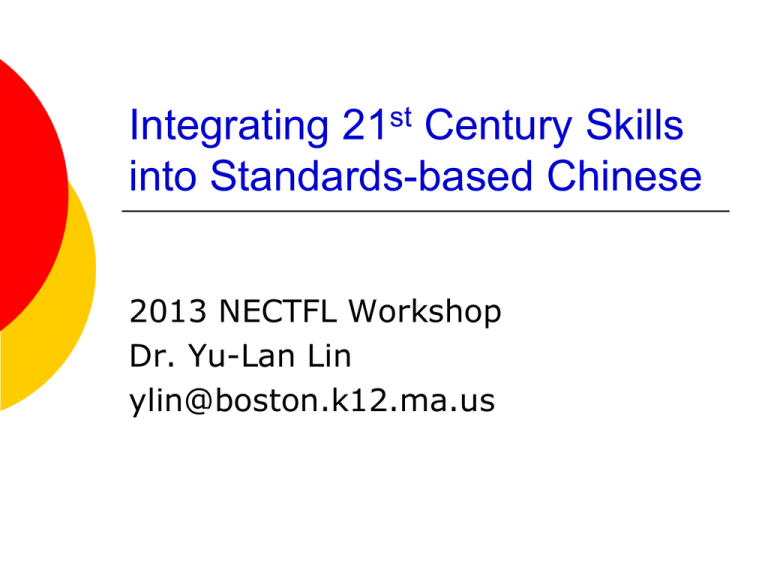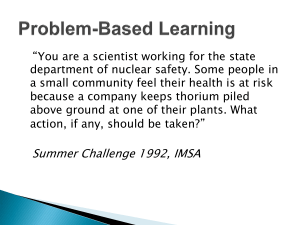Yu Lan Lin workshop
advertisement

Integrating 21st Century Skills into Standards-based Chinese 2013 NECTFL Workshop Dr. Yu-Lan Lin ylin@boston.k12.ma.us Goals 1) Gain a deeper understanding that the standards-based instruction is at the core of today’s language Instruction. Design 5C/P21 learner-centered instructional activities. Traditional Learning 21st Century Learning 21st Century Learner Teaching Methodologies/Approaches Grammar-Translation Method Direct Method Audio-lingual Method Cognitive Approach Proficiency Approach Standards-based Instruction Traditional Language Instruction Cover the content -Use “climb the ladder” model -Learn all basic facts and skills -Excessive teacher talk -Rote memorization -Drills and worksheets -Translation Traditional Language Class • • • • • • • • Heavily dependent on textbooks Isolated voc./ grammar elements Sequential/hierarchical order Practice skills without contexts Little flexibility- ‘correct answers’ Little creativity- ‘fill in the blanks’ Students rarely work cooperatively Rigid test format Consequence of Traditional Teaching Not using content in authentic situations Not using skills in more complex ways Not moving beyond the first rung of ladder Not interesting, not stimulating, not motivating, not engaging students Not learning in a meaningful way Traditional Student Outcome May be able to answer recall questions May be able to perform basic skills Do poorly on application, analysis, and explanation Display boredom, passivity, and apathy Cognitive Approach Krashen’s Hypotheses: 1. The acquisition-learning hypothesis 2. The monitor hypothesis 3. The natural order hypothesis 4. The input hypothesis 5. The affective filter hypothesis The acquisition-learning hypothesis Monitoring Hypothesis Rules monitor acquisition “Correcting” language output Has individual differences Natural Order Hypothesis Follows a predictable ‘natural order’ Independent of the learners' age, L1 background, and conditions of exposure Input Hypothesis Comprehensible Interesting i +1 Not grammatically sequenced Using context Using other cues Krashen’s “i + 1” Affective Filter Hypothesis Affective Filter: -Low motivation, -Low selfconfidence -Anxiety Proficiency Approach Functions Contents Contexts Text types Accuracy Standards-based Instruction 21st Century Skills P 21 Life and Career Skills Learning and Innovation Skills Information, Media and Technology Skills Core Subjects and Themes 21st Century Skills Support: Standards and Assessment Curriculum and Instruction Professional Development Learning Environments Life and Career Skills Flexibility and Adaptability Initiative and Self-Direction Social and Cross-Cultural Skills Productivity and Accountability Leadership and Responsibility Learning and Innovation Skills Creativity Critical Thinking Communication Collaboration Information, Media, Technology Skills Information Literacy Media Literacy Technology Literacy Core Subjects and Themes English World Languages Arts Math Economics Science Geography History Government/Civics Global Awareness Financial, economics, business, entrepreneurial literacy Civic literacy Health literacy Environment literacy Past and Present Learn about the language Teacher-Center Isolated skills Cover a textbook Big “C”, small “c” “One-size-fits-all” instruction Classroom learning Individual work Learn to use the language Learner-Center Integrated skills Backward design Cultural perspectives Differentiated instruction Beyond classroom Group project Present and Future Learn to use the language Learner-Center Integrated skills Backward design Cultural perspectives Differentiated instruction Beyond classroom Group project Native speakers Native materials Native culture Native contexts Global mindset Global approach Global interaction Global issues Standard I: Communication 1.1 : Interpersonal Communication 1.2: Interpretive Communication 1.3: Presentational Communication Teaching Communication Incorporating Technology Literacy When planning to carry out an e-pal exchange with students in China… When planning to present information on the educational system in China… Standard II: Cultures perspectives Practices Products Teaching Culture Incorporating Creativity and Innovation When planning to introduce a familiar story such as 愚公移山… When planning to teach Chinese geography… Standard III: Connections Making Connections Acquiring Information Teaching Connections Incorporating Information Literacy When planning to expand the theme of “clothing” in the unit… When planning to connect with most current event in China, such as Chinese new leaders… Standard IV: Comparisons Linguistic Comparison Cultural Comparison Teaching Comparisons Incorporating Critical Thinking Skills When studying 中秋节… When studying proverbs, such as 画蛇添足… Standard V: Communities School and Community Lifelong Learning Teaching Communities Incorporating Collaboration When studying consumption of energy in China… When engaging in a school wide campaign… Outcomes of 5C/P21 Instruction Away from learning to work towards working to learn Away from memorization towards thinking and understanding Away from students as recipients of information to students as knowledge builders








